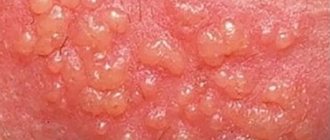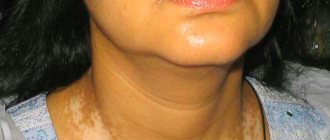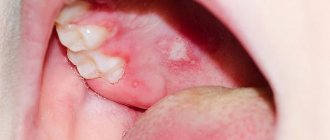The article was prepared by a specialist for informational purposes only. We urge you not to self-medicate. When the first symptoms appear, consult a doctor.
Herpes (from Greek - “creeping”) is a group of widespread diseases caused by viruses of the Herpesvirales order of the Herpesviridae family. The disease manifests itself as lesions of the skin, mucous membranes, nervous tissue, and sometimes internal organs. The clinical picture develops in states of unstable homeostasis. Basically, herpes is a dormant infection, which is characterized by persistence (hidden or latent carriage).
The danger of herpes has been proven when:
- Pregnancy – provokes pathologies of the fetus and newborns, secondary infertility, premature birth, neonatal fetal death;
- Immunodeficiency states of the body - activates the replication mechanism of the immunodeficiency virus, herpes - an indicator of HIV infection (aggravates immunosuppression), causes autoimmune diseases;
- Neoplastic (oncological) diseases - herpes simplex virus type 2 in association with mycoplasmas, chlamydia and other pathogens - a provocateur of the development of malignant pathologies;
- Induction of atherosclerosis – negatively affects a person’s neuropsychic health.
Herpes simplex type 1
The herpes simplex virus combines the first and second serotypes of the herpes virus. Herpes simplex virus type 1 is designated as HSV-1 or HSV-1 (Herpes simplex virus 1). In the clinical literature, it is also called oral (oral) or labial (lip) herpes.
HSV-1 is the most common type of herpes of all those with clinical significance for medicine. Infection usually occurs in the first years of a person's life. The most typical localization of oral or labial herpes is the lips and nasolabial triangle.
Under certain circumstances (immunodeficiency), the virus can also infect:
- The mucous membrane of the genital organs, mouth, nasal cavity and eyes;
- The skin of the fingers and toes (most often the area of the nail fold of the fingers);
- Tissues of the nervous system.
Herpes simplex viruses types 1 and 2 are characterized by:
- Neurotropism is the predominant damage to cells of the nervous system due to the presence or formation of receptors in them that are complementary to viruses;
- Neurovirulence is the ability to cause diseases of the nervous system;
- Suppression of phagocytosis (immune link) to an incomplete level.
Tropism for nervous tissue and the ability of HSV to inhibit phagocytosis are factors indicating the ability of herpes simplex viruses to avoid the effects of the immune system, which makes latent carriage in nervous tissue possible. Persistence in the cells of the nervous system is an important protective and adaptive mechanism of herpes viruses, which allowed HSV-1 to become as widespread as possible in the human population.
Simple type viruses are characterized by two phases of being in the body - latent and manifestation:
- Clinical manifestation of HSV occurs 1-3 times a year, pathogenesis on the lips develops and ends within seven to ten days. The frequency of relapses depends on the person’s immune status; people with immunodeficiency conditions get sick more often;
- The latent (hidden) phase, invisible to the immune system, lasts for the rest of the life of the virus.
Symptoms of herpes type 1
The most common clinical form of HSV-1 in children is vesicular lesions of the lips, sometimes acute respiratory disease. In adults, lesions of the skin, conjunctiva and cornea of the eyes are also observed. With oral-genital contact, HSV-1 manifests itself as damage to the genital organs. Women are infected with the genital form of HSV-1 much more often than men.
The general clinical sign of HSV-1 is intoxication syndrome:
- Fever;
- General weakness;
- Headache;
- Muscle and joint pain.
igg (IgG) positive
For the differential diagnosis of HSV-1 and HSV-2, laboratory methods are used, the purpose of their use is to:
- Determining the type of pathogen based on affinity with the corresponding immunoglobulin;
- Differentiation of the pathogen, for example, HSV-1 from HSV-2;
- Determining the stage of the disease (acute, chronic, latent).
Approximate interpretation of study results when identifying immunoglobulins IgM and IgG:
- IgM is determined by laboratory methods starting from the fifth day of the disease, and IgG is determined only from the second week from the onset of the disease;
- IgM circulates in the peripheral blood for up to three months, and IgG is present in the blood for many years, and in the chronic course of the disease - for life;
- IgM does not penetrate the placenta during pregnancy, but IgG penetrates the placenta in large quantities, that is, detecting it in a pregnant woman who does not have clinical manifestations of herpes means the body is ready to protect itself in case of accidental infection during pregnancy;
- IgM is not able to neutralize the virus and is only a factor in triggering immune processes in the body, while IgG is able to neutralize the virus, therefore it is a factor in the body’s defense.
Detection of IgG specific for HSV-1 in peripheral blood in high titers during the clinical course of the disease using the PCR technique indicates the development of intense immunity to this disease.
Detection of IgG in low titers with a negative PCR reaction indicates a previous illness and that the herpes virus is in a latent state in the body.
Herpes simplex type 1 during pregnancy
Women in general are more susceptible to the herpes simplex virus. It has been proven that the herpes clinic is provoked by conditions that weaken the body’s immune system. Pregnancy and its manifestations (intoxication, hormonal changes) are certainly factors that disrupt homeostasis. Herpes during pregnancy in the form of a clinical manifestation can occur with a high degree of probability.
Herpes simplex virus type 1 is very dangerous for pregnant women because:
- In the normal state of the body, it does not affect the genital organs, meanwhile, during pregnancy, the development of pathogenesis can result in damage to the nervous tissues of the fetus (the virus penetrates the placental barrier);
- During pregnancy, HSV-1 is extremely undesirable, especially during the initial development of clinical manifestations against the background of the absence of protective antibodies (specific immunoglobulins) in the blood, which are formed in response to illness. Moreover, antibodies to HSV-1 do not protect a pregnant woman from HSV-2 (genital form of herpes);
- The herpes simplex virus entering the body in the first half of pregnancy can cause deformities in the fetus;
- HSV-1 or HSV-2, which enters the body of a pregnant woman in late gestation, can cause infection of the fetus during childbirth.
Treatment of herpes type 1
Treatment of viruses of this group has important features:
- Total destruction of the virus is impossible;
- There are no preventive medications;
- Viruses are not sensitive to antibiotics;
- With a short-term course of HSV-1, drug treatment is not advisable.
The only direct acting drug is acyclovir. The pharmaceutical industry produces acyclovir in three formulations (tablets, ointment and solution).
The use of acyclovir in accordance with the instructions can significantly reduce:
- Duration of the clinical course of the disease;
- Frequency of relapses of the disease in clinical form.
Own results
We conducted a study that included 287 men with chronic prostatitis/chronic pelvic pain syndrome IIIA, 23 of whom had infertility. Diagnoses were verified according to the criteria of the European Urological Association [30].
In addition to standard diagnostic procedures, HHV types 4–6 were detected in samples from the urethra, prostate secretion, and ejaculate.
When HHV was detected, patients with infertility (group 1) were prescribed valacyclovir 1000 mg/day for 3 months. and the drug VIFERON® (interferon α-2b in combination with antioxidants (vitamins E and C)) in the form of rectal suppositories. Based on the authors’ personal experience, patients were prescribed the following regimen of drug use: 3 million IU 2 times a day for 10 days, then 3 times a week (also 2 times a day) for the next 3 weeks. Viral load was monitored at the end of 3 months of treatment. The remaining patients in whom HHV types 4–6 were not detected (group II) were prescribed levofloxacin 500 mg for 30 days, tamsulosin 0.4 mg for 3 months, diclofenac suppositories 50 mg for 10 days.
In addition to the acyclic nucleoside, which has a direct antiherpetic effect and is prescribed for the treatment of abacterial prostatitis associated with herpes viruses, VIFERON® was chosen as a drug that can provide a long-term antiviral effect. The drug contains interferon α-2b, which is a human recombinant analogue of a substance produced in any cells of the body. It has antiviral, immunomodulatory, antiproliferative properties, suppresses the replication of RNA and DNA viruses. Interferon α-2b in cells triggers a sequence of reactions leading to suppression of the synthesis of viral proteins, assembly and release of virions into the intercellular matrix. In addition to influencing protein synthesis, interferons have epigenetic activity, activating hundreds of genes that play an important role in the antiviral defense of the cell [31]. In addition, interferon α-2b limits the spread of viral particles by activating the so-called “genome guard” protein p53, which leads to apoptotic death of the infected cell [32]. Ascorbic acid and α-tocopherol acetate, which are part of the drug, are highly active antioxidants, have anti-inflammatory, membrane stabilizing, and regenerating properties.
In 11 patients with identified herpes viruses, electron microscopic examination of sperm was performed (JEM 1400, JEOL, Japan).
We noted that out of 103 patients with detected HHV types 4–6, 8 had infertility (group I), while among 184 patients without herpes viruses, infertility was verified in 15 (group II).
Of the 24 urogenital samples from 8 patients in group I, 12 virus-positive samples were obtained: 7 - ejaculate, 1 - urethral smears, 4 - prostate secretions. CMV and EBV were detected in 4 and 3 samples, respectively, including samples with combinations of 2 HHVs. HHV-6 was much more common - in a total of 7 samples out of all 12. The median viral load of herpes viruses types 4–6 was 1770 copies per 100,000 cells.
As a result of antiviral treatment, by the end of the 3rd month, control studies detected the virus in only 5 of 8 patients in group I, in whom herpes viruses were detected in 5 bioassays. At the same time, the median viral load in them decreased to 48 copies per 100,000 cells.
As a result of therapy for 6 months. after the end of treatment, pregnancy was observed in the spouses of 10 out of 23 men, who were distributed into groups as follows: 6 out of 8 from group I and 4 out of 10 from group II. Statistical analysis showed that differences in pregnancy rates reached significant significance between groups I and II (χ2 criterion value was 4.960, critical χ2 value at the significance level p=0.05 was 3.841, significance level p=0.026).
The effect of the course of antiviral therapy was also assessed by electron microscopy. A study of spermatozoa of 11 patients with infertility showed that if before treatment, HHV capsids of types 4–6 were found in 8 patients, then after treatment in 4 of these patients, viral capsids were no longer detected in spermatozoa, and in 3 other patients the number of spermatozoa with capsids was on average decreased by more than 2 times: from 12% to 5% of infected gametes in the ejaculate (Fig. 1).
Herpes simplex virus type 2
Herpes simplex virus type 2 is briefly called HSV-2 or HSV-2 (Herpes simplex virus 2). In the clinical literature it is referred to as genital or anogenital (localization of lesions in the anus and genitals). Under certain conditions, genital herpes can affect other parts of the body; even systemic lesions have been established in PIH-2. HSV-2 is usually transmitted through sexual contact.
Distinctive signs of the clinical course of the disease caused by herpes simplex virus type 2:
- The number of individuals seropositive for HSV-2 increases with the onset of puberty and is directly proportional to the number of sexual partners;
- Women are infected with HSV-2 six times more often than men;
- Antibodies to HSV-1 do not prevent HSV-2 infection;
- Genital symptoms (skin lesions in the genital area, perineum, anus, lower extremities and buttocks) in approximately 80% of cases are a consequence of HSV-2 infection;
- Asymptomatic or atypical course of HSV-2 occurs in approximately 70% of cases of IgG detection;
- HSV-2, unlike HSV-1, is characterized by frequent relapses of clinical manifestations (up to 75% of patients with genital herpes suffer from it constantly);
- HSV-2 in 15% of cases of the disease causes malignancy (malignant degeneration) of the tissues of the cervix in women and the prostate gland in men. Therefore, individuals seropositive for VPR-2 are recommended to undergo regular testing for tumor markers;
- HSV-2 in women is accompanied by a high incidence of gynecological diseases, leading to decreased reproductive function.
IgG antibodies to herpes type 2
The principles of immunological diagnostics are identical to the methods used in studies of HSV-1. Examination of a woman planning a pregnancy for the presence of IgG to herpes type 2 helps to identify gynecological diseases and provide timely treatment, which increases the likelihood of a normal gestational period and the birth of a healthy child. The father of the unborn child must undergo a similar serological test to determine IgG. Moreover, if IgG is detected in the blood, it is recommended to use PCR to verify the absence of HSV-2 in the semen of the examined man.
Herpes type 2 during pregnancy
According to information published in available sources intended for neonatologists, a comparative description of two types of herpes simplex during pregnancy is given. The second type of virus in pregnant women provokes miscarriages and polyhydramnios, increases the likelihood of miscarriage, and in men it is a common cause of infertility. The most dangerous consequence of contracting HSV-2 during pregnancy is neonatal herpes (NG).
Neonatal herpes is a disease of newborns caused by infection of the fetus with HSV-2 or HSV-1, with an unfavorable prognosis for the newborn. This disease occurs with a frequency of approximately one case in two thousand births. The mortality rate of newborns, according to some data, reaches 70%. Timely detection and active therapy reduces mortality by up to 20%. The prognosis for the negative development of neonatal herpes is higher in children infected with HSV-2.
Treatment of herpes virus type 2
Treatment for HSV-2 is similar to that for herpes simplex type 1. Due to the more severe course of the disease, the treatment regimen according to indications includes various types of immunocorrectors, agents that strengthen the body’s defenses (vitamins, biostimulants), as well as physiological solutions to reduce the concentration of the pathogen in the blood. It is possible to use other drugs of different pharmacological groups.
Introduction
Infertility is a pressing medical and social problem.
In Russia, every fifth married couple is infertile [1]. Moreover, the male factor is responsible for half of these cases. This is associated with a progressive decline in reproductive function. There is numerous data on the negative impact of viruses on the state of the male reproductive system. Human herpes viruses (HHV) are widespread in the human population [2]. Herpes viruses cause lifelong infection and are the cause of many diseases, half of which have a relapsing course. From 95% to 100% of the population are infected with HHV, and at different periods of life a person is infected with at least one, and more often, several types of viruses belonging to the herpesvirus family. In the second half of life, almost all people have antibodies to most HHVs [3]. 8 types of herpes viruses are pathogenic for humans.
Herpes type 3
The third type of herpes virus is the varicella zoster virus or herpes zoster virus (VZO-OG, Human herpesvirus 3, HHV-3, Varicella-zoster (VZV). The herpes zoster virus enters the body of a susceptible person through airborne droplets or household contact. Infection causes chickenpox in childhood. After contracting chickenpox, the child remains a lifelong carrier of the VZV virus. The virus is localized in the tissues of the nervous system. Recurrences of herpes zoster in adults cause a disease called herpes zoster (Zoster).
Symptoms of VZO-OG in childhood are pronounced. Usually the disease has a benign course (mostly complete recovery). The acute phase lasts up to two months.
The main symptoms of chickenpox:
- Severe skin itching;
- High body temperature;
- Extensive skin rashes (vesicles).
The localization of the rash coincides with the projection of the nerve trunks on the skin. After the disappearance of clinical symptoms, the virus becomes inactive and localizes in the nervous tissue. Carrying the herpes zoster virus lasts for life. Relapses can occur in people when the protective properties of the immune system decrease. In the classical view of epidemiology, zoster recurs and manifests itself clinically in people over fifty years of age. In recent years, this pattern has been broken. Recurrence of the disease caused by herpes zoster is called herpes zoster.
The main symptoms of herpes zoster:
- Severe pain along the nerve trunks for 3-12 days;
- Hyperthermia (increased general body temperature);
- Swelling and redness of the skin, after 1-3 days – rashes in the form of vesicles;
- After 2-3 weeks, the disease ends with recovery after scarring of the crusts at the site of the vesicles.
Complications of herpetic lichen are ganglionitis (inflammation of a nerve ganglion) or ganglioneuritis (inflammation of several nerve ganglia). Diseases are manifested by allergies, skin ulcers, conjunctivitis and eczema. Regular relapses of herpetic lichen are characteristic of immunodeficiencies.
Treatment of diseases caused by herpes type 3 (varicella in children and herpes zoster in adults) is carried out in a hospital or on an outpatient basis after differential diagnosis and determination of the individual characteristics of the pathogenesis of the patient.
EPB and CMV
During primary infection in children, Epstein-Barr virus and cytomegalovirus most often manifest as infectious mononucleosis.
The appearance is noted:
- tonsillitis (tonsillitis);
- febrile and intoxication symptoms;
- lymphadenitis (mainly the cervical and submandibular lymph nodes enlarge);
- hepatosplenomegaly (increase in liver and spleen size).
When taking ampicillin, an ampicillin rash is common.
Blood tests are characterized by the development of monocytosis and the appearance of atypical mononuclear cells. To confirm the diagnosis, a test for immunoglobulins of class M and G for CMV and EPB is used.
Attention. During pregnancy, exacerbation of CMP and PEP can lead to intrauterine infection of the fetus (developmental delay, damage to the central nervous system, intrauterine fetal death), as well as spontaneous abortions and miscarriage.
In weakened patients, CMV and EPB can lead to damage to the structures of the central nervous system, damage to internal organs, and the development of herpetic sepsis (mainly CMV). Retinitis and colitis may also develop.
To diagnose CMV and EPB, tests for Ig (M and G) and DNA of herpes viruses are used.
Herpes type 4
Herpes virus type 4 – Epstein-Barr virus (EBV) or Epstein-Barr virus, Human Herpes Virus type 4. Epstein-Barr virus causes infectious mononucleosis. The clinical picture develops in individuals with immunodeficiencies.
Infectious mononucleosis is a lesion of the mucous membranes of the oropharynx and lymph nodes, which is characterized by high fever, possible damage to the liver and spleen, and changes in the morphology of blood cells (atypical mononuclear cells). People usually get mononucleosis during adolescence or young adulthood. Infection is airborne or contact (including oral-genital). The incubation period is from 5 to 50 days.
The main symptoms of mononucleosis:
- A sharp increase in body temperature to 38-40 °C;
- Pain syndrome (headache, muscle pain, joint pain);
- Feeling of chronic fatigue and drowsiness (lasts up to several months after the disappearance of other symptoms);
- Swelling and swelling of the mucous membrane of the oropharynx (laryngitis and pharyngitis);
- Gray or white-yellow plaque on the tonsils;
- Papular rash on the skin and mucous membranes, which lasts from one to three days and then disappears without a trace;
- An increase in the number of lymphocytes in the peripheral blood and the presence of specific (atypical) lymphocytes - mononuclear cells.
Diagnostics is complemented by detection of Epstein-Barr virus DNA using the PCR method. Treatment is carried out under the supervision of doctors of various specialties. Epstein-Barr virus sometimes provokes the development of a malignant disease - Burkitt's lymphoma.
Symptoms of the disease
The symptoms of herpes type 4 depend on the disease caused by the virus.
Infectious mononucleosis
Initially, the disease manifests itself as decreased appetite, weakness and mild fever. At further stages, the disease is characterized by signs of ulcerative necrotic or catarrhal tonsillitis. In this case, fibrous films appear in the patient’s oral cavity.
Why can our articles be trusted?
We make health information clear, accessible and relevant.
- All articles are checked by practicing doctors.
- We take scientific literature and the latest research as a basis.
- We publish detailed articles that answer all questions.
Type 4 herpes is accompanied by the following symptoms:
- muscle pain;
- dizziness;
- gagging ;
- loss of appetite;
- drowsiness;
- swelling of the pharynx;
- nasal congestion
- headache ;
- sweating;
- hyperemia of the oropharyngeal mucosa;
- general weakness;
- high temperature (up to 40 degrees);
- decreased performance.
These symptoms can easily be confused with a sore throat or pharyngitis. Such signs are observed in the first stages of the disease (on the second to fourth days after infection).
Enlarged lymph nodes are also considered an important symptom when diagnosing pathology. Their compaction, mobility, and pain on palpation are observed. Lymphadenopathy spreads to the submandibular, posterior cervical, and sometimes inguinal nodes.
In some cases, hemorrhagic (subcutaneous hemorrhages in the form of dots) or urticarial rashes (itchy pink blisters) appear on the skin and mucous membranes.
Internal organs also suffer - the spleen and liver become significantly enlarged. In this case, patients experience a change in the shade of urine and yellowness of the sclera of the eyes. These signs are observed for a long time - almost up to one month.
Burkitt's lymphoma
According to statistics, the disease is a common complication of infection with the Epstein-Barr virus. This pathology is accompanied by hyperthermia and increased sweating.
The disease is characterized by the formation of multiple or single tumors on the jaw. Burkitt's lymphoma causes difficulty swallowing, shortness of breath, weight loss, and tooth loss.
There are two forms of this disease:
- Generalized. The oncological process spreads to the spinal cord and spine. It manifests itself as a violation of motor coordination and decreased sensitivity of the legs and arms.
- The abdominal form, which affects the digestive organs (liver, intestines, pancreas). With pathology, dyspeptic disorders and pain in the abdominal area occur. Intestinal obstruction and ascites may develop.
The disease occurs in four stages. In the final stages, bone tissue and the nervous system are affected.
Nasopharyngeal carcinoma
With this pathological condition the following symptoms occur:
- difficulty breathing through the nose;
- noise and ringing in the ears;
- loss ;
- purulent nasal discharge with bloody clots;
- headache .
If symptoms of mononullosis and malignant processes appear, it is important to consult a specialist in a timely manner. After diagnosis, appropriate treatment is prescribed that will help prevent unwanted consequences and alleviate the patient’s condition.
Herpes type 5
Herpes virus type 5 is cytomegalovirus (CMV) or HHV-5 (Human herpesvirus 5). Clinical symptoms of cytomegalovirus infection rarely develop. Basically, there is a sluggish virus carriage. Infection is airborne, contact (kissing, sexual intercourse, blood transfusion, in utero, through breast milk). Infection is confirmed by the detection of giant cells - cytomegal cells - in human blood. The clinical picture develops with weakened immunity. The incubation period is up to 60 days.
Symptoms of cytomegalovirus infection resemble a cold:
- High temperature, fatigue;
- Pain syndrome (head, joints, throat);
- Unlike mononucleosis, there is no inflammation of the tonsils and enlargement of regional lymph nodes;
- Damage to the kidneys, liver, spleen, pancreas, central nervous system, eyes.
Cytomegalovirus can have a significant negative impact on the course of pregnancy. It penetrates the placental barrier, causing infection and deformities in the fetus. Currently, this is the most common cause of neonatal pathologies, and sometimes the death of newborn children.
A child with congenital cytomegalovirus infection may suffer from:
- Underdevelopment of the brain;
- Damage to the organs of hearing and vision;
- Delayed general development;
- Inflammatory phenomena in the respiratory and digestive organs;
- Skin rashes.
Diagnosis of herpes type 5
CMV is diagnosed based on:
- Instrumental methods - ultrasound study of blood flow in the vessels of the umbilical cord and uterus, measurement of heart rate (heart rate), determination of oligohydramnios, delays in fetal development, pathologies of its internal organs;
- Laboratory methods - detection of cells by electron microscopy, PCR analysis, serological studies to detect antibodies to CMV.
Treatment of a pregnant woman and the advisability of continuing the pregnancy are determined by the doctor based on a series of examinations. Primary infection after conception is a direct indication for artificial termination of pregnancy. General strengthening medications, immunocorrection and symptomatic therapy are prescribed as the main therapy.
What are genital herpes?
The development of genital herpes is usually caused by the herpes virus type 2. In isolated cases, damage to the genital organs is associated with infection with type 1 virus.
For reference. With the development of genital herpes, the appearance of herpetic eruptions on the mucous membrane of the genital organs is noted. In the area of the rash there is severe itching and severe pain. The pain often radiates to the lower abdomen and inner thigh.
Sometimes the rash spreads to the thighs and buttocks. Often, in addition to the skin and mucous membrane of the external part of the genitals, the mucous membrane of the vagina and urethra is affected.
With the development of herpetic urethritis, pain and pain during urination and itching in the urethra are noted. Bloody and mucous discharge may appear.
In severe cases of genital herpes, suppuration of the contents of the vesicles is possible due to the addition of a secondary tank. infections, it is also possible to develop an ascending infection with the addition of adnexitis, salpingo-oophoritis, cystitis, prostatitis.
General symptoms are also noted: fever, intoxication, weakness, irritability.
The diagnosis is usually made based on the clinical picture of the disease.
To detect carriage of herpes simplex virus type 2 (examination is usually carried out during pregnancy or when planning it) or to confirm the diagnosis in controversial situations, PCR, RPHA, and ELISA can be used.
Herpes type 6 in adults
Herpes virus type 6 is referred to as HHV-6 or HHV-6. This is the common name for the human herpes virus of two subtypes homologous to each other. In adults, the HCH-6A subtype is active as one of the provocateurs of the development of multiple sclerosis.
Multiple sclerosis is a multifactorial autoimmune disease with a predominant lesion of the central nervous system, which is diagnosed in people 20 years of age and older, and very rarely in other age groups.
The most important facts about herpes virus type 6:
- The presence of this particular type of herpes virus in the etiopathogenesis of multiple sclerosis has been proven;
- The clinical picture of MS is chronic inflammation of nerve tissues, including the myelin layer of the brain - demyelination, which is accompanied by degenerative processes in nerve tissues;
- Without treatment, multiple sclerosis inevitably leads to disability, social and psychological isolation of the patient.
There are four types of multiple sclerosis:
- Primary progressive multiple sclerosis. The patient’s condition is characterized by a steady deterioration, a short-term subsidence of the process is possible, and then a rapid relapse;
- Secondary progressive multiple sclerosis. Characteristic periods of exacerbation after the first wave of the disease;
- Remitting-progressive multiple sclerosis (Latin remitto - weaken). At a certain point, the signs of the disease disappear, and then there is a sharp return and increase in symptoms;
- Relapsing-remitting multiple sclerosis. It is characterized by periods of disappearance and recovery of symptoms; a long-term stable condition of the patient is observed without visible signs of deterioration in well-being.
Symptoms of herpes type 6
Early symptoms of multiple sclerosis:
- Fatigue, depression;
- Unsteadiness of gait, poor coordination of movements;
- Change in sensitivity (temperature, vibration and tactile).
The main symptoms of MS, which characterize significant changes in the body, in addition to early signs that usually persist and worsen:
- Cognitive disorders, rapid mood swings;
- Visual disturbances (defocus in the form of double vision, decreased visual acuity);
- Difficulties with articulation when speaking (unusual pronunciation of words);
- Dysphagia (impaired swallowing);
- Spasms and cramps;
- Deterioration of sensitivity (lack of pain response);
- Fecal and urinary incontinence, constipation and diarrhea;
- Erectile disfunction.
The nature and degree of manifestation of symptoms of multiple sclerosis are varied, which is associated with the unpredictability of areas of damage to nervous tissue.
Treatment of herpes type 6
For the treatment of multiple sclerosis the following is used:
- Corticosteroids (methylprednisolone, dexamethasone and others);
- Antioxidants, antiplatelet agents, angioprotectors;
- Proteolysis inhibitors;
- Plasmapheresis with drugs;
- Immunomodulators, for example Copaxone;
- Stimulators of interferon production (Betaferon, Rebif, Avonesk);
- Immunoglobulins intravenously, for example, Sandoglobin.
Drugs from other groups may be indicated, depending on the stage and form of the disease. Symptomatic therapy and medical and social rehabilitation of patients with multiple sclerosis prevents the development of complications.
Which herpes viruses are dangerous for humans?
Herpesvirus infections are a large group of infectious diseases caused by various herpesviruses.
For reference. A specific feature of all types of herpes viruses is their ability to persist in the human body for life (persist), periodically provoking relapses of herpes virus infection.
It should be taken into account that different types of the herpes virus cause different diseases.
According to the ICD10 classification, different types of herpes accordingly have different codes:
- B00 for simple herpes infections (types of herpes 1 and 2);
- B01 for chickenpox;
- B02 for herpes zoster;
- B08.2 for sudden exanthems (diseases of the 6th type of herpes virus);
- B25 for cytomegalovirus infections;
- B27 for infectious mononucleosis.
In patients with normal immune systems, herpes viruses often circulate in the body asymptomatically.
Attention. At the same time, in patients with reduced immunity, herpetic diseases can be severe and accompanied by the development of multiple complications (damage to the central nervous system, herpetic hepatitis, damage to the mucous membranes of internal organs, generalization of infection and the development of herpetic sepsis).
Also, some herpes viruses have malignant activity and can provoke the development of lymphomas, cervical cancer (cervical cancer), and Kaposi's sarcomas.
Herpes type 7
Herpes virus type 7 is referred to as HHV-7 or HHV-7. Often this type of virus is combined with herpes virus type six. HCH-7 is a possible cause of chronic fatigue syndrome and cancer of lymphoid tissue.
Symptoms of herpes type 7
The following main symptoms of herpes type 7 are distinguished:
- Weakness due to lack of physical stress, increased nervousness;
- Light physical activity is accompanied by rapid fatigue;
- Excessive increase in suspiciousness;
- Chronic depressive conditions;
- Sleep disorders (insomnia);
- Long-term (up to 6 months in a row) subfebrile body temperature;
- Enlarged lymph nodes.
Anamnesis and physical examination methods are complemented by laboratory tests:
- Polymerase chain reaction (PCR) - detection of the genetic material of the virus,
- Enzyme-linked immunosorbent assay (ELISA) – determination of IgG titers;
- Immunogram with determination of subpopulations of T- and B-lymphocytes (decrease in the content of natural killer cells and increase in circulating immune complexes).
Treatment of herpes virus type 7 consists of antiviral therapy aimed at strengthening the immune system. Preventive measures have not been developed.
Types of herpes on the body
The main types of herpes that have manifestations on the body (specific herpetic rashes) include herpes simplex viruses type 1 and 2, as well as the varicella-zoster virus.
Infectious mononucleoses caused by Epstein-Barr viruses and cytomegalovirus are rarely accompanied by the appearance of rashes.
For reference. As a rule, with infectious mononucleosis, a rash appears after taking ampicillin - “ampicillin rash”.
Viruses 6 and 7 can cause sudden exanthema of newborns.
Herpes type 8
Herpes virus type eight is designated as HHV-8 or HHV-8. This pathogen infects lymphocytes, moreover, it can remain latent in the body of healthy people for a long time. Herpes virus type 8 is transmitted by contact, during organ transplantation, through the placenta from mother to fetus, during pregnancy and during childbirth, and during the movement of the fetus through the birth canal. The disease is activated due to radiation therapy.
Symptoms of herpes type 8
Symptoms of herpes type 8 should be considered, given that HCH-8 causes a number of cancers:
- Kaposi's sarcoma;
- Primary lymphoma;
- Castleman's disease.
Kaposi's sarcoma
Kaposi's sarcoma is an oncological disease characterized by the formation of multiple tumors due to malignant degeneration of blood vessels.
Kaposi's sarcoma is localized to:
- Skin;
- Mucous membranes;
- Lymph nodes;
- Internal organs.
There are four types of Kaposi's sarcoma:
- Classic type. Occurs in elderly and senile men. The disease manifests itself on the skin of the hands, on the ears and cheeks, on the forehead and mucous membrane of the mouth, as well as on the genitals in the form of multiple symmetrical spots, nodules and plaques;
- Endemic type. Widespread only in Africa;
- Immunosuppressive type. Develops while taking immunosuppressants;
- Epidemic type. Develops as a complication in AIDS patients. Characterized by a very rapid course of pathogenesis with damage to the lymph nodes and internal organs.
Treatment of Kaposi's sarcoma: surgical method (cryotherapy), medication (administration of interferon, cytostatics, antitumor and antiviral drugs), radiation therapy.
Primary lymphoma
This is an oncological disease with a predominant lesion of the serous membranes, which is characterized by the accumulation of fluids containing tumor cells in the body cavities. Primary lymphoma is treated only with chemotherapy.
Castleman disease
Manifested by enlarged lymph nodes (subclavian and mesenteric, as well as in the lungs and neck). There are three types of Castleman disease: hyaline-vascular, plasma cell and multifocal. Treatment of the disease is surgical or with radiation therapy.
Author of the article:
Kuzmina Vera Valerievna |
Endocrinologist, nutritionist Education: Diploma of the Russian State Medical University named after. N.I. Pirogov, specialty “General Medicine” (2004). Residency at the Moscow State Medical and Dental University, diploma in Endocrinology (2006). Our authors
How can you get infected with herpes
The source of herpetic infection is a sick person during the period of activation of herpetic infection.
Infection with herpes can be carried out:
- airborne droplets (when coughing, sneezing, talking);
- contact (by contact with mucous membranes or skin affected by the blistering rash);
- sexually;
- transplacentally (during pregnancy) and during the passage of the fetus through the mother’s birth canal;
- by household means (using shared dishes, towels).
For reference. At the same time, viruses of types 1 and 3 are transmitted mainly by airborne droplets, herpes simplex viruses of type 2 are transmitted sexually, children are infected with cytomegalovirus and Epstein-Barr virus through contact with adults (kissing relatives, sharing dishes).









